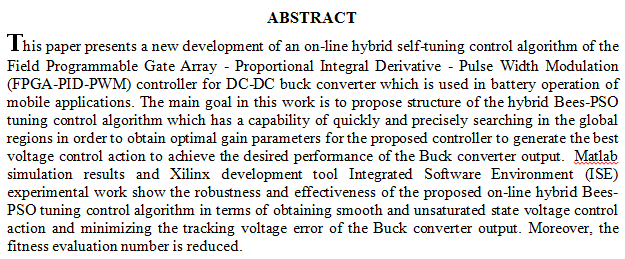
The variation in wing morphological features was investigated using geometric morphometric technique of the Sand Fly from two Iraqi provinces Babylon and Diyala . We distributed eleven landmarks on the wings of Sand Fly species. By using the centroid size and shape together, all species were clearly distinguished. It is clear from these results that the wing analysis is an essential method for future geometric morphometry studies to distinguish the species of Sand Flies in Iraq.
 (1)
(1)
The ring modulator described in part I of this paper is designed here for two operating wavelengths 1550nm and 1310nm. For each wavelength, three structures are designed corresponding to three values of polymer slot widths (40, 50 and 60nm). The performance of these modulators are simulated using COMSOL software (version 4.3b) and the results are discussed and compared with theoretical predictions. The performance of intensity modulation/direct detection short range and long rang optical communication systems incorporating the designed modulators is simulated for 40 and 100Gb/s data rates using Optisystem software (version 12). The results reveal that an average energy per bit as low as 0.05fJ can be obtained when the 1550nm modulator is d
... Show MoreThe aim of this study is to show the concepts of nuclear shape and the geometrical picture to the even-even nuclei of 164,166,168E isotopes in the context of the Interacting boson Model IBM-1. The energy spectra were calculated and the effective charge values (eB) of the electromagnetic transition strength were obtained and used to calculate the B(E2) values of the electromagnetic transitions and the quadrupole moment Q of 2+ -states. The Hamiltonian parameters were calculated by taking in account the properties of these nuclei. Comparison were made with the available experimental data and included in tables. The geometrical picture of these nuclei were looked at by calculating the deformation which were represented by the potentia
... Show MoreCoupling reaction of 2-amino benzoic acid with 8-hydroxy quinoline gave bidentate azo ligand. The prepared ligand has been identified by Microelemental Analysis,1HNMR,FT-IR and UV-Vis spectroscopic techniques. Treatment of the prepared ligand with the following metal ions (ZnII,CdII and HgII) in aqueous ethanol with a 1:2 M:L ratio and at optimum pH, yielded a series of neutral complexes of the general formula [M(L)2]. The prepared complexes have been characterized by using flame atomic absorption, (C.H.N) Analysis, FT-IR and UV-Vis spectroscopic methods as well as conductivity measurements. The nature of the complexes formed were studied following the mole ratio and continuous variation methods, Beer's law obeyed over a concentration ra
... Show MoreThis paper aims to study the chemical degradation of Brilliant Green in water via photo-Fenton (H2O2/Fe2+/UV) and Fenton (H2O2/Fe2+) reaction. Fe- B nano particles are applied as incrustation in the inner wall surface of reactor. The data form X- Ray diffraction (XRD) analysis that Fe- B nanocomposite catalyst consist mainly of SiO2 (quartz) and Fe2O3 (hematite) crystallites. B.G dye degradation is estimated to discover the catalytic action of Fe- B synthesized surface in the presence of UVC light and hydrogen peroxide. B.G dye solution with 10 ppm primary concentration is reduced by 99.9% under the later parameter 2ml H2O2, pH= 7, temperature =25°C within 10 min. It is clear that pH of the solution affects the photo- catalytic degradation
... Show MoreSpray pyrolysis technique was used to make Carbon60-Zinc oxide (C60-ZnO) thin films, and chemical, structural, antibacterial, and optical characterizations regarding such nanocomposite have been done prior to and following treatment. Fullerene peaks in C60-ZnO thin films are identical and appear at the same angles. Following the treatment of the plasma, the existence regarding fullerene peaks in the thin films investigated suggests that the crystallographic quality related to C60-ZnO thin films has enhanced. Following plasma treatment, field emission scanning electron microscopy (FESEM) images regarding a C60-ZnO thin film indicate that both zinc oxide and fullerene particles had shrunk in the size and have an even distribution. In addition
... Show More (1)
(1)
 (1)
(1)
The primary goal of in-situ load testing is to evaluate the safety and performance of a structural system under particular loading conditions. Advancements in building techniques, analytical tools, and monitoring instruments are prompting the evaluation of the appropriate loading value, loading process, and examination criteria. The procedure for testing reinforced concrete (RC) structures on-site, as outlined in the ACI Building Code, involves conducting a 24-h load test and applying specific evaluation criteria. This article detailed a retrofitting project for an RC slab-beams system by utilizing carbon fiber-reinforced polymer (CFRP) sheets to strengthen the structure following a fire incident. The RC structure showed indicators of deter
... Show More (5)
(5)
 (4)
(4)
